8.18892
Polyethylene glycol
35000, (stabilised with 2-tert-butyl-4-methoxyphenol) for synthesis
동의어(들):
Poly(ethylene glycol), Polyethylene glycol 35000, Polyglycol, Polyethylene oxide, Polyoxy ethylene, PEG 35000, PEG
로그인조직 및 계약 가격 보기
모든 사진(1)
About This Item
Linear Formula:
H(OCH2CH2)nOH
CAS Number:
MDL number:
UNSPSC 코드:
13111021
EC 인덱스 번호:
500-038-2
NACRES:
NA.22
추천 제품
vapor pressure
<0.01 hPa ( 20 °C)
Quality Level
형태
liquid
autoignition temp.
>320 °C
효능
28000 mg/kg LD50, oral (Rat)
>20000 mg/kg LD50, skin (Rabbit)
pH
5-7 (20 °C, 100 g/L in H2O)
mp
60-65 °C
전이 온도
flash point 260 °C
solubility
500 g/L
density
1.2 g/cm3 at 20 °C
벌크 밀도
400‑500 kg/m3
저장 온도
2-30°C
SMILES string
C(CO)O
InChI
1S/C2H6O2/c3-1-2-4/h3-4H,1-2H2
InChI key
LYCAIKOWRPUZTN-UHFFFAOYSA-N
유사한 제품을 찾으십니까? 방문 제품 비교 안내
애플리케이션
Polyethylene glycol 35000 (PEG 35000) is a hydrophilic polyether compound that can be used to synthesize:
It can also be used as:
- Hierarchically structured silica monoliths for the fabrication of micro-bioreactors.
- Micro-nanostructured PEG-DA (PEG-diacrylates) hydrogels for biomedical applications.
It can also be used as:
- A template to prepare micro/mesoporous structure of silica by sol-gel process.
- A stabilizing agent in the synthesis of metal nanoparticles.
분석 메모
Hydroxyl value: 3 - 4
Melting range (lower value): ≥ 62 °C
Melting range (upper value): ≤ 67 °C
Average molecular mass: 28000 - 38000
Identity (IR): passes test
Melting range (lower value): ≥ 62 °C
Melting range (upper value): ≤ 67 °C
Average molecular mass: 28000 - 38000
Identity (IR): passes test
Storage Class Code
10 - Combustible liquids
WGK
WGK 1
Flash Point (°F)
281.5 °F - closed cup
Flash Point (°C)
138.6 °C - closed cup
시험 성적서(COA)
제품의 로트/배치 번호를 입력하여 시험 성적서(COA)을 검색하십시오. 로트 및 배치 번호는 제품 라벨에 있는 ‘로트’ 또는 ‘배치’라는 용어 뒤에서 찾을 수 있습니다.
이미 열람한 고객
Synthesis of micro/mesoporous silica using poly (ethylene glycol) as a template
Kuznetsova TF, et al.
Colloid Journal, 74(4), 489-494 (2012)
Immobilization of invertase on silica monoliths with hierarchical pore structure to obtain continuous flow enzymatic microreactors of high performance
Szymanska K, et al.
Microporous and Mesoporous Materials : The Official Journal of the International Zeolite Association, 170, 75-82 (2013)
A Mandal et al.
Proceedings of the Institution of Mechanical Engineers. Part H, Journal of engineering in medicine, 227(11), 1224-1236 (2013-08-21)
Silver and magnetic (Fe3O4) nanoparticles have attracted wide attention as novel antimicrobial agents due to their unique chemical and physical properties. In order to study the comparative effects on antibacterial and animal cytotoxicity, Staphylococcus aureus and NIH 3T3 fibroblasts were
Polymeric substrates with tunable elasticity and nanoscopically controlled biomolecule presentation.
Daniel Aydin et al.
Langmuir : the ACS journal of surfaces and colloids, 26(19), 15472-15480 (2010-09-14)
Despite tremendous progress in recent years, nanopatterning of hydrated polymeric systems such as hydrogels still represents a major challenge. Here, we employ block copolymer nanolithography to arrange gold nanoparticles on a solid template, followed by the transfer of the pattern
자사의 과학자팀은 생명 과학, 재료 과학, 화학 합성, 크로마토그래피, 분석 및 기타 많은 영역을 포함한 모든 과학 분야에 경험이 있습니다..
고객지원팀으로 연락바랍니다.


